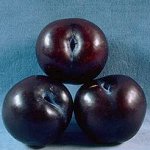|
|
|
Prune-Plums (dried Plums) Fruit Facts Page Information
|
Availability by variety
|
 Certain varieties of plums have such firm flesh and such a high
sugar content that they can be dried with little loss of their original
plumpness and flavor. These plums are called prune-plums, and the dried
plums themselves are called prunes.
Certain varieties of plums have such firm flesh and such a high
sugar content that they can be dried with little loss of their original
plumpness and flavor. These plums are called prune-plums, and the dried
plums themselves are called prunes.
Plums are divided into three groups--European, Japanese,
and native North American--based on their geographic origins.
European plums include the familiar blue fruits commonly found in European
and American markets. They are widely grown in California. The tart damson
plums, from which jams and jellies are made, belong to this group, as do the
firm sweet varieties that are dried to make prunes.
It is believed that the ancient peoples of the Middle East were the first to
dry plums to make prunes. Prunes have been prepared for centuries in France,
and the prunes from the region around Agen are still considered by many
to be the best in the world. Today, orchards in California, which use
Agen plums almost exclusively, yield a major share of the world's prunes.
Prunes are also produced in some central European and South American countries.
Nutrition and Consumption:
Prunes are a good source of vitamins A and B, are high in fiber, and are rich
in iron, calcium, and phosphorus. Their pulp is used as food for infants.
Prunes are eaten raw, soaked or stewed alone or with other fruits, and
used in jams and desserts. The pulp, stewed fruit, and juice are packaged
commercially.
Detailed nutritional informatin can be found by searching the
USDA Nutritional Database
. Enter "Prune or Plum" (no quotes) as the keyword and select the
link and report of interest.
Scientific classification:
Plums belong to the genus Prunus of the family Rosaceae. The common
European plum is classified as Prunus domestica, the Japanese plum as
Prunus salicina, and the Damson plum as Prunus insititia.
|
|